Ten Inconvenient Truths About Ukraine Largely Ignored by the Media (1)
Introduction
There is no doubt, war is ugly. Atrocities are committed by all belligerents involved in conflict.
Propaganda is heightened and intensified not only by the major participants, but also by countries, governments, organisations, corporations, and persons who aren’t directly involved in the conflict. Each has their own motivations, reasons, and self-serving interests for doing so.
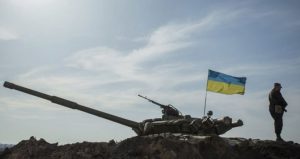
“Fog of war” – a German expression author Nebel des Krieges coined by Prussian general Carl von Clausewitz – is often used to describe the uncertainty in situational awareness experienced by participants in military operations.
The expression can also easily be used to describe the fog that occurs between people’s ears when they are bombarded with propaganda pushed by countless parties which most often completely distorts the true realities of the conflict or war in question.
War is emotional. And when emotions are high and people are gaslighted, reason and judgement are often easily thrown out the window.
The absence or omission of truthful information and picking sides also contribute to a lack of balanced reporting on such conflicts.
Too often, the very powerful mainstream press is incentivised to report a prevailing narrative that, more often than not, serves the vested interests of those to whom they are all too willing to oblige their allegiances to.
Journalists and independent or alternative media outlets that provide reporting that is counter to these prevailing narratives are often labelled as conspiracy theorists or other derogatory labels.
This is done so because those who are attacking them cannot counter the merits of their claims and reporting, and thus must resort to attacking their character instead.
Unfortunately, this is a logical fallacy that most of the general public fall for.
Now we present the ugly, inconvenient truths that the mainstream media refuse to show to their audiences with regards to the Ukraine and the Russia-Ukraine war.
NATO’s expansion towards Russia’s borders
For those not entirely familiar with NATO, or the North Atlantic Treaty Organization, here is a summary by Al Jazeera:
“The North Atlantic Treaty Organisation (NATO) was founded in 1949 by 12 member states – Belgium, Canada, Denmark, France, Iceland, Italy, Luxembourg, the Netherlands, Norway, Portugal, the United Kingdom and the United States – and was established to curb Soviet expansion and encourage political integration in Europe in the aftermath of World War II.
The 30-member alliance is meant to guarantee political and military protections, and allow European and North American nations to discuss security concerns.”
One of the main reasons for its existence was to “curb Soviet expansion”, as stated above. The rationale being that the West viewed the Soviet communist system as a grave threat after World War II.
Moreover, as the Soviet Union and the United States were embroiled in the Cold War from 1947 to 1991, the U.S. sought to expand its sphere of political and military influence, particularly in Europe.
After the Dissolution of the Soviet Union in 1991, 15 former Soviet Republics became sovereign states.
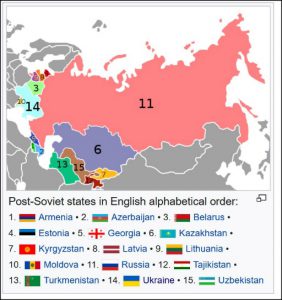
Though many of these states as well as their people have retained close ties with Russia, three of them acceded membership into NATO in 2004; namely, Estonia, Latvia, Lithuania. Two of these countries, Estonia and Latvia share a border with Russia.
Recall that NATO originally had 12 members.
A CNBC article provides two maps showing the expansion of NATO since 1991 towards Russia. The first map shows Europe in 1990, the year after the Berlin wall fell:

Their second map, as of 2022, clearly shows the expansion of NATO membership over the past 32 years since the reunification of Germany:
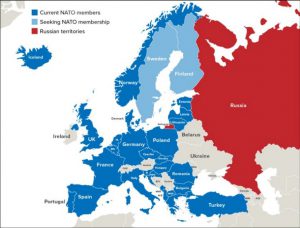
From this second map above showing 2022 NATO countries in blue, we can also notice Sweden and Finland (in light blue) who are currently vying for NATO membership.
Since the early 1990s, Russia has been worried about NATO expanding closer to its borders. While various agreements had been made between Russia and Europe not to expand NATO eastward, several of them were broken.
The main worry is that NATO members can have military bases that hold nuclear missiles for which member countries, such as the United States, have an ample supply of.
There is plenty of evidence that confirms that such military bases (particularly from the U.S. and NATO) exist and are located in Russia’s immediate neighbors of Estonia, Latvia, and Lithuania. U.S. and NATO military bases, personnel, and operations are not limited to these three countries, for there are many more in other NATO countries near Russia such as Poland, Hungary, and Bulgaria.
In recent years, Russian President Vladimir Putin has sought guarantees from NATO and many of its European members that it would halt its eastward expansion and end military cooperation with Ukraine and Georgia, which are not members, observed Al Jazeera. Both Georgia and the Ukraine share borders with Russia and the latter has a significantly long border with the biggest former member of the Soviet bloc.
It would thus come as no surprise that Russia and its current leader, Vladimir Putin, would consider it more than hostile should either of these two countries were to join NATO. Many would argue that having military bases, some with nuclear arsenals, within only several kilometers from your doorstep poses a significant threat to the safety, protection, and territorial integrity of a nation and its people.
Was this not the case when the Soviet Union had stationed nuclear missiles in Cuba, less than 100 miles away from the United States? If that was not acceptable to President John F. Kennedy and the U.S. administration, then how is it different for Vladimir Putin and his administration? Should they not be granted the same right?
These questions need to be considered and contemplated prior to outrightly accusing Putin of “aggression” and invasion against the Ukraine, or any other close neighbor, for that matter.
Also according to the Al Jazeera article, in February 2022, Putin said Russia’s “special operation” in Ukraine was a means to stop NATO’s growth, which he perceives as an encroachment. Only in recent weeks has Putin called the conflict with the Ukraine a war. Perhaps this is so because he had not anticipated the level and extent of Western support Kiev has received over the past year.
While some would argue that the invasion was nevertheless unjustified, ample evidence exists that show that prior promises and agreements to not allow the expansion of NATO eastward were broken by NATO members and NATO itself.
Here are but two of these broken promises which everyone seems to forget about.
A secret document from March 1991 titled QUADRIPARTITE MEETING OF POLITICAL DIRECTORS, BONN, 6, MARCH: SECURITY IN CENTRAL AND EASTERN EUROPE showed a pledge to Moscow by the United States, Germany, France, and the United Kingdom, that they would not extend NATO eastward and would not offer membership to Poland.
The document was found in the UK National Archives by Joshua Shifrinson, a political science professor at Boston University in the US and shared with Der Spiegel. It had been marked “Secret” but was declassified at some point.
Specifically, here is part of what was it stated:
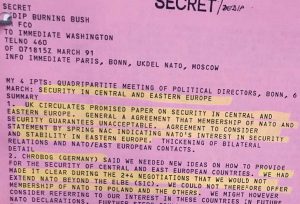
As the reader may notice from the image above, the parties stated: “WE HAD MADE IT CLEAR DURING THE 2+4 NEGOTIATIONS THAT WE WOULD NOT EXTEND NATO BYOND THE ELBE (SIC).”
The “2+4 negotiations” simply refers to the reunification of Germany (i.e., East Germany with West Germany) with NATO remaining an integral part of the reunified country.
In July 2014, NATO itself called the eastward expansion a “myth,” as per its published piece titled NATO enlargement and Russia: myths and realities. In that piece, a few questions were raised about the “enlargement conundrum”:
“Does the absence of a promise not to enlarge NATO mean that the West never had any obligations vis-à-vis Russia? Did the enlargement policy of Western institutions therefore proceed without taking Russian interests into account? Again, the facts tell a different story.”
However, NATO was not counting on the QUADRIPARTITE MEETING OF POLITICAL DIRECTORS, BONN, 6, MARCH: SECURITY IN CENTRAL AND EASTERN EUROPE secret document to be released to the public. In black and white, it confirms that a promise, or agreement, by NATO not to expand did take place. So, this myth, or “conspiracy theory” turned out to be conspiracy fact.
It is no wonder that Moscow hold a fervent distrust of NATO, the United States, and its other Western allies.
The secret 1991 document also revealed the following:
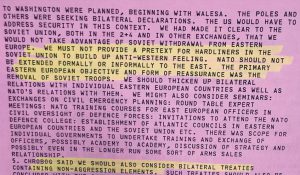
“WE HAD MADE IT CLEAR TO THE SOVIET UNION, BOTH IN THE 2+4 AND IN OTHER EXCHANGES, THAT WE WOULD NOT TAKE ADVANTAGE OF SOVIET WITHDRAWAL FROM EASTERN EUROPE. WE MUST NOT PROVIDE A PRETEXT FOR HARDLINERS IN THE SOVIET UNION TO BUILD UP ANTI-WESTERN FEELING. NATO SHOULD NOT BE EXTENDED FORMALLY OR INFORMALLY TO THE EAST. THE PRIMARY EASTERN EUROPEAN OBJECTIVE AND FORM OF REASSURANCE WAS THE REMOVAL OF SOVIET TROOPS.”
As you can see, the promise was indeed made. The Soviet withdrawal did occur. Yet NATO expanded anyhow, including in Poland for which they had also explicitly stated they would not.
If NATO has lied about this broken promise, then how many others have they lied about and broken? And, more importantly, should they be trusted?
That is not the only promise NATO has broken with Russia.
Read the second part of the article
yogaesoteric
February 6, 2023
